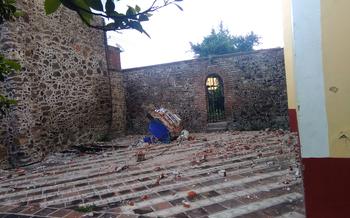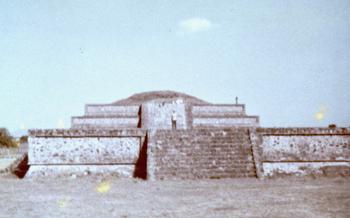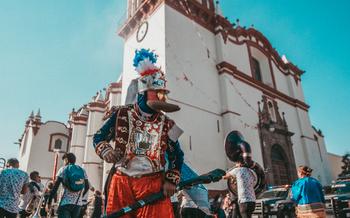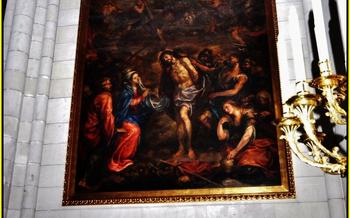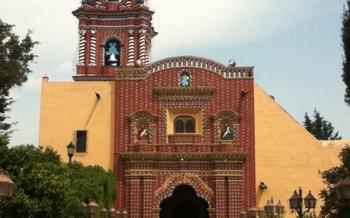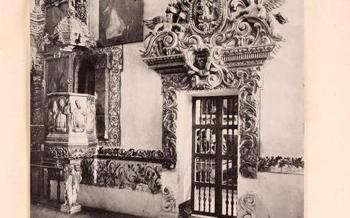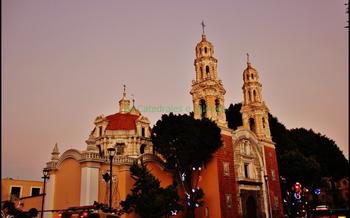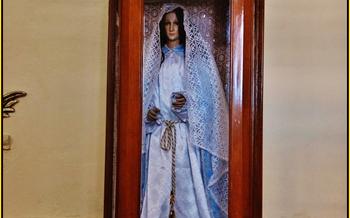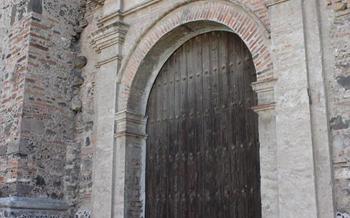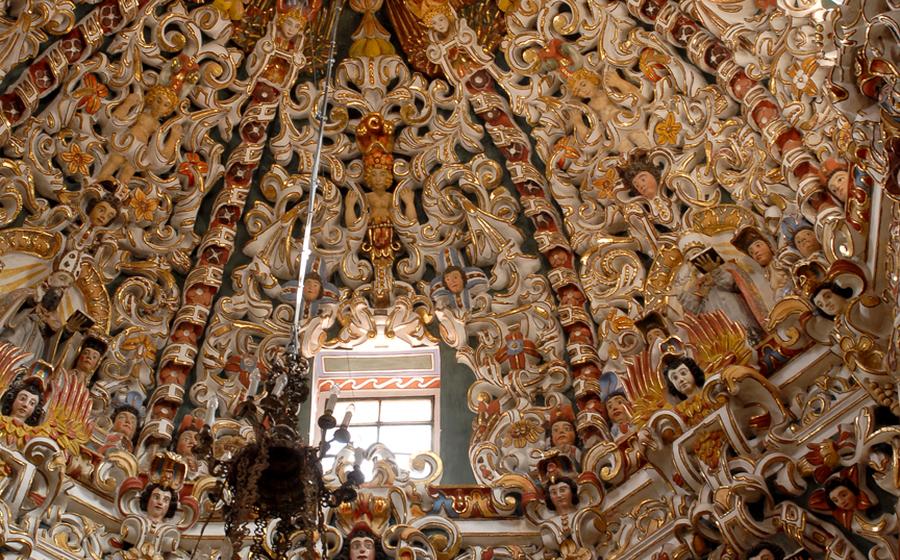
Tonantzintla Church
- The Tonantzintla Church: A Tapestry of History and Faith
- Architectural Highlights
- Interior Grandeur
- Cultural and Religious Significance
- Admission and Visiting Hours
- Location and Getting There
- Exploring the Surroundings
- Photography and Videography
- Accessibility and Facilities
- Local Customs and Etiquette
- Safety and Security
- Suggested Tours and Itineraries:
- Local Cuisine and Gastronomic Delights:
- Hidden Gems and Off-the-Beaten-Path Attractions
- Insider Tip: Unraveling the Secrets of the Confessional
The Tonantzintla Church: A Tapestry of History and Faith
stands as a testament to the rich cultural and religious heritage of the region. Its construction began in the early 16th century, a time marked by the convergence of indigenous traditions and the arrival of Spanish Catholicism. The church's design reflects this unique blend, seamlessly intertwining European architectural elements with intricate indigenous motifs.
The church's construction was driven by the Augustinian friars, who sought to establish a spiritual center that would bridge the gap between the indigenous population and the newly introduced Catholic faith. The indigenous community, deeply rooted in their own beliefs and traditions, played a significant role in the church's construction, contributing their artistic and cultural expertise to the project.
As a result, the Tonantzintla Church emerged as a harmonious fusion of two distinct worlds. Its very existence speaks to the remarkable ability of different cultures to coexist and collaborate, creating something truly extraordinary and enduring. Today, the church stands as a symbol of faith, cultural exchange, and the enduring spirit of the Mexican people.
Architectural Highlights
The Tonantzintla Church stands as a testament to the fusion of European and indigenous architectural styles, resulting in a distinctive masterpiece that captivates all who behold it. Its ornate facade, a symphony of intricate carvings and colorful tiles, is a visual feast that transports visitors to a realm of artistic wonder. The church's exterior is adorned with a profusion of cherubs, saints, and mythical creatures, each meticulously crafted to narrate biblical tales and legends.
The church's interior is no less awe-inspiring, featuring a breathtaking display of gold leaf altarpieces, intricate frescoes, and stunning stained glass windows. The intricate carvings and paintings depict scenes from the Bible, the lives of saints, and the history of the church, creating a vibrant tapestry of religious iconography.
The symbolism embedded in the church's architecture is profound and multifaceted. The octagonal dome, a unique feature, represents the unity of the divine and the earthly realms. The four entrances symbolize the four cardinal directions, welcoming pilgrims from all corners of the world.
The fusion of European and indigenous elements is evident throughout the church's design. The Moorish-inspired arches, reminiscent of Islamic architecture, blend harmoniously with the indigenous motifs and iconography, creating a unique and cohesive architectural style.
Exploring the Tonantzintla Church is akin to embarking on a journey through time and cultures, where the legacy of two worlds intertwines to create a masterpiece of architectural brilliance.
Interior Grandeur
The interior of the Tonantzintla Church is a testament to the opulence and artistry of the Baroque era. Step inside, and be greeted by a symphony of gold, color, and intricate details that will leave you in awe. The walls and ceilings are adorned with lavish gold leaf altarpieces, each one a masterpiece of religious art. The altarpieces depict scenes from the Bible and the lives of saints, showcasing the exceptional craftsmanship and attention to detail that went into their creation.
Look up and marvel at the stunning frescoes that cover the vaults of the church. These vibrant paintings depict biblical scenes, angels, and cherubs, creating a sense of divine grandeur. The vibrant colors and intricate brushwork bring the stories to life, inviting visitors to contemplate their religious significance.
The stained glass windows of the Tonantzintla Church are another highlight of the interior. These colorful windows allow natural light to filter into the church, casting a warm glow on the interior. The intricate designs and vibrant hues of the stained glass create a kaleidoscope of colors that dance on the walls, adding to the overall splendor of the church.
Cultural and Religious Significance
The Tonantzintla Church holds immense cultural and religious significance, attracting pilgrims and visitors from around the world.
-
It serves as a pilgrimage site for both Catholics and indigenous peoples, who come to pay homage to the Virgin of Tonantzintla, a revered figure associated with fertility and protection.
-
Legends and beliefs surround the church, including the story of the Virgin's miraculous appearance to a humble indigenous farmer.
-
Annual celebrations and festivals are held at the church, showcasing the vibrant cultural heritage of the region. These celebrations feature colorful processions, traditional music and dance performances, and lively markets.
-
The church's intricate iconography and symbolism reflect the blending of indigenous and Catholic beliefs, making it a unique and powerful representation of Mexico's rich cultural heritage.
Admission and Visiting Hours
Visiting the Tonantzintla Church is a unique and enriching experience that offers a glimpse into the rich cultural and religious heritage of Puebla. The church is open to the public from 8:00 AM to 6:00 PM every day, except for major holidays when special arrangements may apply.
Admission to the church is free for all visitors, making it an accessible attraction for travelers of all backgrounds. However, donations are welcome and greatly appreciated, as they contribute to the ongoing maintenance and preservation of this architectural masterpiece.
Guided tours are available for visitors who wish to delve deeper into the history and significance of the church. These tours are conducted by knowledgeable guides who provide insights into the church's construction, symbolism, and cultural importance.
To fully appreciate the church's beauty and tranquility, it is recommended to visit during weekdays when there are fewer crowds. Early mornings or late afternoons offer the best lighting conditions for photography enthusiasts to capture the intricate details of the church's architecture.
Audio guides are also available for rent, offering visitors a self-guided tour experience with detailed information about the church's history, artwork, and symbolism. These audio guides can be particularly useful for visitors who prefer to explore at their own pace.
Location and Getting There
The Tonantzintla Church is conveniently located within the city of Puebla, approximately 15 kilometers (9 miles)la, Puebla. To reach the church, visitors can take public transportation, such as buses or taxis, from various points in the city. The journey from the city center takes around 30 minutes by car or taxi, offering a scenic route through the city's vibrant neighborhoods. Ample parking is available near the church for those traveling by private vehicle.
Exploring the Surroundings
Beyond the exquisite beauty of the Tonantzintla Church, visitors can immerse themselves in the rich cultural tapestry of the surrounding area. Just a short distance away lies the historic center of Puebla, a UNESCO World Heritage Site renowned for its colonial architecture, vibrant plazas, and bustling markets. Take a leisurely stroll through the cobblestone streets, admiring the colorful facades and grand cathedrals that line the way. Don't miss the opportunity to visit the Talavera workshops, where skilled artisans create the iconic blue-and-white pottery that Puebla is famous for.
For a taste of local flavors, venture into the culinary scene that surrounds the church. Indulge in the mouthwatering dishes of traditional Poblano cuisine, such as mole poblano, a complex and flavorful sauce served with chicken or turkey, or chalupas, crispy tortillas topped with shredded beef or pork. Satisfy your sweet tooth with cemitas, fluffy bread rolls filled with savory fillings like cheese, avocado, and meat.
To make the most of your time, consider exploring the area on foot. A leisurely walk or a guided tour will allow you to discover hidden gems, such as charming cafes, quaint boutiques, and art galleries tucked away in the narrow streets. Whether you prefer to wander aimlessly or follow a curated itinerary, the surroundings of the Tonantzintla Church offer a wealth of experiences to enrich your visit.
Photography and Videography
Capturing the Splendor: Guidelines for Photography Enthusiasts
The Tonantzintla Church's breathtaking beauty and intricate details make it a photographer's paradise. While capturing its essence through photography is encouraged, certain guidelines ensure respect for the sacred space and the privacy of visitors.
Respect the Sacred Space:
-
Photography and videography are permitted within the church premises, but visitors must prioritize maintaining a respectful and solemn atmosphere.
-
Avoid using flash photography, as it can be distracting and disruptive during religious services or prayers.
Capture the Essence:
-
Look for unique angles and perspectives to showcase the church's architectural details, vibrant colors, and intricate artwork.
-
Experiment with natural lighting to emphasize the interplay of light and shadow on the church's facade and interiors.
Be Mindful of Others:
- Be considerate of other visitors, especially during peak hours or religious ceremonies. Avoid blocking walkways or obstructing the views of others.
Professional Photography:
- For professional photography sessions or commercial purposes, prior permission from the church authorities is required. Contact the church office in advance to obtain the necessary permits.
Share Your Masterpieces:
- Share your stunning captures with the world! Tag your photos with #TonantzintlaChurch and #Puebla on social media to inspire fellow travelers and photography enthusiasts.
Accessibility and Facilities
The Tonantzintla Church is committed to providing an accessible and enjoyable experience for all visitors. Wheelchair ramps and elevators are available to ensure that individuals with disabilities can fully explore the church's interior. Restrooms and drinking fountains are conveniently located within the church premises, catering to the needs of visitors. For those seeking a break or refreshment, there are several restaurants and cafes in the vicinity, offering a range of culinary options.
Local Customs and Etiquette
When visiting the Tonantzintla Church, it is essential to be mindful of local customs and etiquette to ensure a respectful and enjoyable experience. Dressing modestly, covering shoulders and knees, is recommended as a sign of respect for the religious significance of the church. Visitors should be mindful of their behavior, maintaining a quiet and reverent atmosphere while inside the church. Photography is generally permitted, but using flash or taking photos during religious services is discouraged. It is important to remember that the church is an active place of worship, and visitors should be respectful of ongoing religious activities. Engaging with the local community, greeting people with a friendly "Hola" and asking for permission before taking photos of individuals, demonstrates respect for local customs. By observing these simple guidelines, visitors can contribute to the preservation of the church's sacred atmosphere and show appreciation for the local culture.
Safety and Security
Visiting the Tonantzintla Church is generally considered safe, as the area surrounding the church is well-lit and patrolled by local authorities. However, it's essential to exercise basic safety precautions, as with any travel destination. Be vigilant and aware of your surroundings, especially at night or when traveling alone. Avoid carrying large amounts of cash or valuables, and keep your belongings close at hand. If you have any concerns or witness any suspicious activity, don't hesitate to approach a church official or local law enforcement for assistance. Remember, the safety of visitors is a top priority for the local community, and they are committed to ensuring a positive and secure experience for all.
Suggested Tours and Itineraries:
To enhance your experience and delve deeper into the history and significance of the Tonantzintla Church, consider joining a guided tour or following a curated itinerary. Several tour operators offer comprehensive packages that include a visit to the church, along with other notable landmarks and attractions in Puebla. These tours often provide insightful commentary from knowledgeable guides who can share fascinating stories and anecdotes about the church's past.
One popular itinerary combines a visit to the Tonantzintla Church with the Puebla Cathedral, the Amparo Museum, and the Barrio del Artista. This full-day tour allows visitors to explore the city's rich cultural and historical heritage, encompassing religious architecture, art, and local traditions. Guided tours typically last around 5-6 hours and may include transportation, entrance fees, and lunch.
For a more personalized experience, consider hiring a private guide who can tailor the itinerary to your interests and preferences. They can take you to hidden gems and lesser-known attractions, ensuring you make the most of your time in Puebla. Costs for guided tours and itineraries vary depending on the duration, group size, and inclusions. Be sure to book in advance, especially during peak tourist season, to avoid disappointment.
Local Cuisine and Gastronomic Delights:
Indulge your taste buds with the vibrant flavors of Puebla's renowned cuisine while exploring the vicinity of the Tonantzintla Church. Step into nearby restaurants or eateries and savor the authentic taste of traditional Poblano dishes, such as mole poblano, a complex and flavorful sauce served over chicken or turkey, and chalupas, crispy tortillas topped with shredded chicken, salsa, and fresh cheese. Don't miss the opportunity to try cemitas, a local sandwich filled with various meats, vegetables, and the signature cemita bread.
Embrace the culinary journey by seeking recommendations from locals or fellow travelers. Ask about their favorite dishes and hidden culinary gems. Venture into the side streets and discover small, family-run eateries that offer a glimpse into the true flavors of Puebla. Whether it's a hearty breakfast of chilaquiles or a refreshing bowl of traditional Mexican soup, the culinary delights of Puebla are sure to tantalize your palate and leave you craving for more.
Hidden Gems and Off-the-Beaten-Path Attractions
While the Tonantzintla Church is undoubtedly a must-see attraction, exploring the surrounding area reveals hidden gems and off-the-beaten-path attractions that offer a deeper glimpse into the region's rich history and culture. One such hidden gem is the nearby Church of San Francisco Acatepec, an architectural marvel showcasing a unique blend of indigenous and Baroque styles. Its ornate facade, intricate carvings, and stunning interior frescoes rival those of the Tonantzintla Church, making it a worthy destination for history and art enthusiasts. For those seeking a more immersive experience, consider venturing beyond the city limits to explore the ancient ruins of Cantona, a pre-Hispanic city that predates the arrival of the Spanish. Here, visitors can wander among the remnants of a once-thriving civilization, marveling at the ingenuity and artistry of the ancient builders.
Insider Tip: Unraveling the Secrets of the Confessional
As you step inside the Tonantzintla Church, take a moment to explore the hidden gem concealed within its walls – the confessional. While most visitors admire the grand altarpieces and intricate frescoes, few venture into this secluded corner. The confessional, with its intricate carvings and colorful tiles, is a masterpiece in its own right. Peer through the small window and let your imagination wander as you contemplate the secrets whispered within these sacred walls. This hidden treasure offers a unique glimpse into the church's rich history and the lives of those who have sought solace and guidance within its embrace. Discover the hidden stories that lie beneath the surface of this remarkable edifice, making your visit to the Tonantzintla Church a truly immersive and unforgettable experience.
